Contents
A barn for bulls is planned taking into account the number of livestock. Additionally, take into account the characteristic features of the breed, a number of other nuances. To build a farm building on your own, you need to have minimal building skills, but first you need to clearly understand the requirements for a barn.
Requirements for a cattle shed
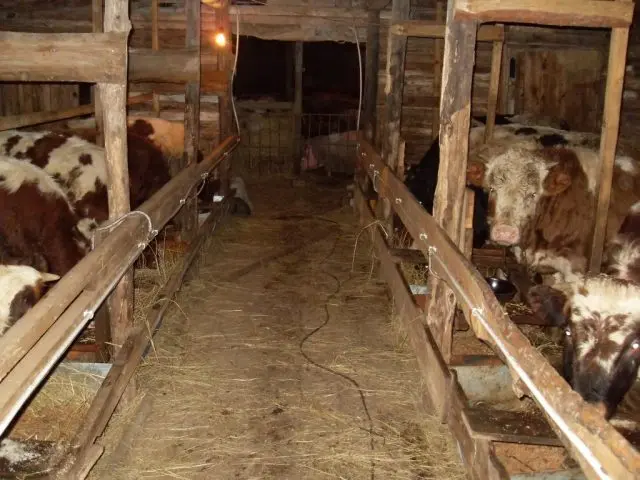
A barn is to bulls what a house is to a man. Here everything should be thought out: walls, floor, ceiling, interior arrangement. Animals spend at least 10 hours a day indoors. In winter, cows stay here almost around the clock. So that cattle do not experience discomfort, a number of important requirements are imposed on the barn:
- ensuring complete safety for animals and the people who care for them;
- reliable fixation of cattle during maintenance work;
- free access to drink and food, the availability of devices for abruptly stopping feeding;
- the presence of free space so that the animal can lie, stand, freely enter and exit;
- the internal arrangement should be thought out in such a way as to reduce the number and time of maintenance work to a minimum in the future.
It is useful to take bulls out of the barn even in the cold season. To ensure the comfort of walking for animals, you need to take care of the paddock. A fenced area is being built near the barn. The size depends on the number of livestock. From above, the corral is covered with a canopy, put deaf side partitions.
How to build a barn for cattle with your own hands
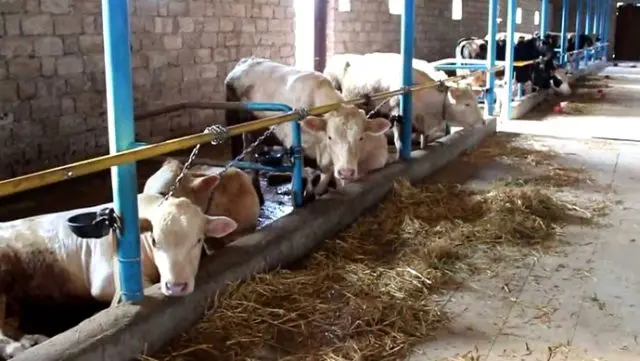
Having decided to build a barn for bulls, it is necessary to take into account the features of the agricultural structure. In addition to adults, calves will be kept in the barn, and they are more whimsical. For the cold season, you will need to build individual houses. The easiest option is to fold them from straw bales. Inside the house, the calf will be warm, dry, comfortable.
A modern type of housing for young animals is a plastic box. The house is made of a durable polymer, it is well washed from dirt, and can be treated with disinfectants. Light boxing can be freely carried by two people around the barn, put in the right place. The house is equipped with a doorway. There is a dry feed dispenser, a hay compartment. Under the dome of the box, heat is perfectly retained. The calf feels comfortable.
When building a barn for keeping cows, it is important to foresee which breeds of cattle will be kept here in the future. Animals of each species differ in size. A stationary shed made of blocks or other material is considered reliable. If we talk about practicality, then the sliding barn comes first. The structure is built from shields. The material for the manufacture of a sliding barn are boards, metal pipes, a profile, a wooden bar. In the future, if necessary, such a barn can be quickly disassembled and reassembled for resizing.
Bulls and heifers of different ages will be kept inside the barn. Each animal will need a stall. Young animals are given less footage, and an adult animal – more space. The size of the stall should ensure the free stay of bulls and cows. The animal is given just enough space to go to bed, turn around freely, go to the feeder, drinker. The width of the stall should be enough for a person to freely approach the cow and milk it.
However, it is impossible to greatly overestimate the size of free space. In addition to not saving space inside the barn, there is a problem of unsanitary conditions. In a stall that is too wide, the bulls feel at ease. Freely take out food from the feeder, scatter it on the floor. There is a problem of rapid contamination of the litter.
See the video for more information about bull sheds:
Create a plan
To build a barn, you will need to develop a plan, create a drawing with dimensions. The scheme begins to be sketched out when the number of bulls to be kept is already determined.
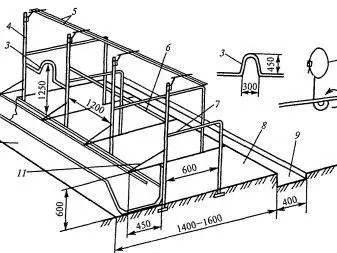

When they are going to build a barn for calves and adult bulls, in addition to drawing up drawings, the plan takes into account the location of the outbuilding in a private yard. It is optimal to remove the barn at 20 m from residential buildings, water sources, and other vital objects. If it is impossible to fulfill the requirement due to the restriction of the territory, the distance is reduced to 15 m.
When the issue with the construction site of the barn is resolved, they return to drawing up drawings. When determining the size of the barn, one adult bull or cow is assigned a plot 1,1-1,2 m wide, 1,7-2,1 m long. Young bulls have different requirements, which is associated with their active mobility. The plot is allotted with a width of 1,25 m, a length of 1,4 m.
When calculating the size of the stall, feeders are taken into account. They must be removed from the bulls. The steam coming out of the nostrils at a close location of the feeder will fall on the food. It will quickly become damp, covered with mold.
The ceiling height of the barn is equipped according to the standard of 2,5 m. This parameter is enough for bulls and maintenance personnel. If the barn turned out to be 3 m high, there is nothing to worry about. Worse if barn ceilings are too low. Bulls and attendants are uncomfortable: movement is limited, the accumulation of dampness and harmful gases increases inside the barn.
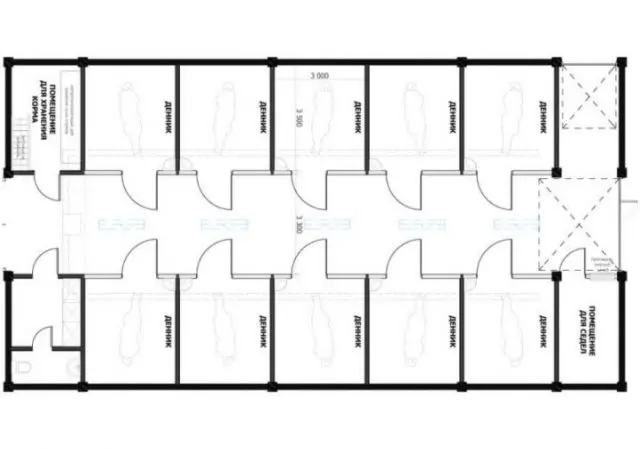
Knowing how much area one bull needs, multiply the value by the number of livestock contained. The result will display the total dimensions of the barn, but without the paddock. If a large number of bulls are expected to be kept, double-sided stalls are equipped inside the barn. A free path at least 1,5 m wide is left between the rows of sections. It is advisable to make a through passage in the barn by installing doors at the end of the building.
Necessary tools and building materials
A barn for bulls is often erected from those materials that are available to the owner. A tree is considered a good option. The material is available, inexpensive, has good thermal insulation properties. Inside the wooden barn, the bulls will be warm and cozy. If blocks, bricks are available, then this material can be used to build walls. The roof of barns is usually erected from inexpensive materials. Suitable slate, roofing material, corrugated board.
The tool for erecting a barn for bulls is selected taking into account the selected building material. In any case, you will need:
- shovel;
- Master OK;
- a hammer;
- Bulgarian;
- saw;
- screwdriver.
If you build stone walls for a barn, pour a strip foundation, it is advisable to have a concrete mixer. Hand pounding a large amount of mortar is very difficult.
Construction works
The process of erecting a barn for keeping bulls consists of several stages, each of which involves the construction of a certain part of the building: foundation, floor, walls, roof, ceiling. The last stage is the internal arrangement of the barn.
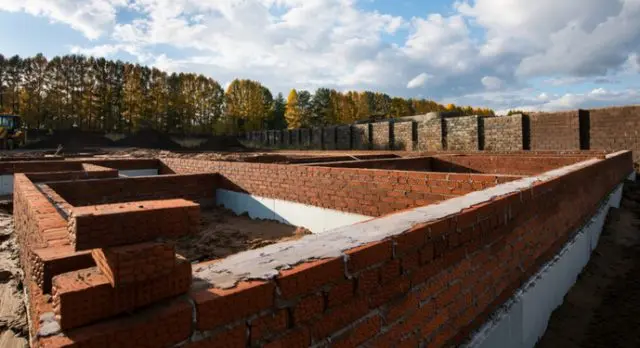
The construction of the barn begins with the foundation. It depends on its strength how long the building for keeping bulls will last. Sheds are usually placed on a strip or column base. It is important to consider that the bulls create an additional heavy load on the foundation. If a wooden shed is erected for 2-3 bulls, then a columnar base is sufficient. It is clear from the name that the foundation consists of separate concrete pillars installed at a certain distance along the perimeter of the future cowshed.
Large sheds, where a herd of bulls is supposed to be kept, as well as buildings with stone walls, are placed on a strip foundation. A trench is dug under a monolithic base, the walls are covered with roofing material. Formwork is installed around the perimeter. Inside the trench from the rods, a reinforcing frame is connected. Concrete is poured in layers. It is desirable to complete the work in a day, otherwise a monolithic base will not work.
The depth of the foundation of the barn is laid below the point of seasonal freezing of the soil. If the soil on the site is heaving, additional measures are taken to strengthen it. Sometimes, for difficult areas, a strip foundation is combined with a columnar base, thick layers of crushed stone and sand are poured.
The floor in the barn needs to be durable. Bulls create an impressive load with their weight. Boards quickly deteriorate. Wood wears out from hooves. Dampness has a negative effect. Worn boards begin to break under the weight of the bulls. In addition, the wood is saturated with the smell of manure.
Ideal strength provides a concrete floor. The covering is steady against dampness, maintains the big weight of bulls, does not absorb smells of manure. The disadvantage is that the concrete is cold. Bulls will catch a cold, get sick.
It is optimal for bulls to make a combined floor in the barn. The base is poured with concrete. Removable wooden shields are laid on top. If necessary, they are taken out into the street, cleaned, disinfected, dried. Additional warmth for the bulls is provided by a bedding of hay or straw on the floor.
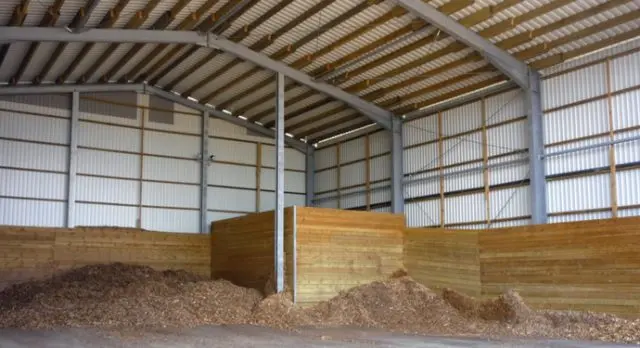
The walls of the barn for a small herd of bulls are built of wood. For such a building, a frame is assembled from a beam, placed on a columnar foundation, sheathed with a board. If it is supposed to keep a large herd of bulls from 20 heads, then brick or blocks are chosen for the construction of the walls of the cowshed.
Small ventilation vents are installed in the walls at a height of 2,5 m from the floorboards. Ventilation in summer provides fresh air. In winter, the barn vents are closed to save heat. For ventilation, air ducts with adjustable dampers are installed.
Windows are installed on the walls with an indent of 1,2 m from the floor. They provide daylight to the barn. It is advisable to equip the windows of the barn with vents in order to carry out ventilation.
The roof is single-pitched or double-pitched. The first option is simpler, but not practical. The gable roof of the barn forms an attic. Due to the additional enclosed space, it is better to keep warm inside the barn in winter. The attic is used for storing hay, working equipment.
The rafter system acts as the frame of the roof of the barn. Waterproofing and roofing are laid on the crate. A shed canopy is launched from the roof, covering the entire area of uXNUMXbuXNUMXbthe paddock.
The interior of the barn
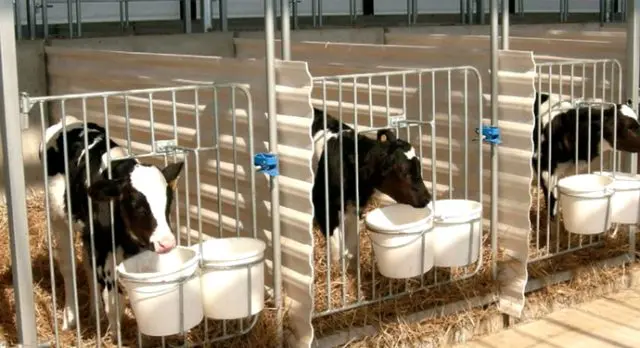
The arrangement of the barn begins with the installation of a corral for each bull. The structure is made from durable materials. Usually they use metal or put concrete partitions. A feeder and a drinker are hung on the outer wall of the stall. They will be available to animals and owners for maintenance.
Homemade feeders are made in the form of boxes with a height of opposite sides of 30 and 75 cm. The low part is located towards the stall. The animal will freely get food, but not throw it over the high opposite side.
Feeders and drinkers are not placed on the floor. It is optimal to raise them about 10 cm from the flooring. The best option is an automatic drinker with an uninterrupted water supply. It can be installed even in the far corner of the stall.
Conclusion
The barn for bulls, if necessary, can be converted to contain other animals or poultry. Only the internal arrangement of the barn is changed, and the building itself continues to fulfill its functional duties.









